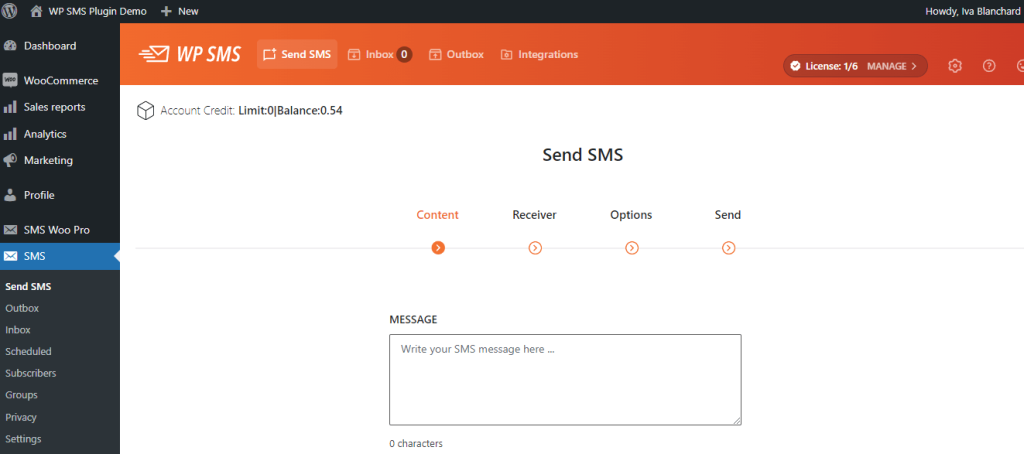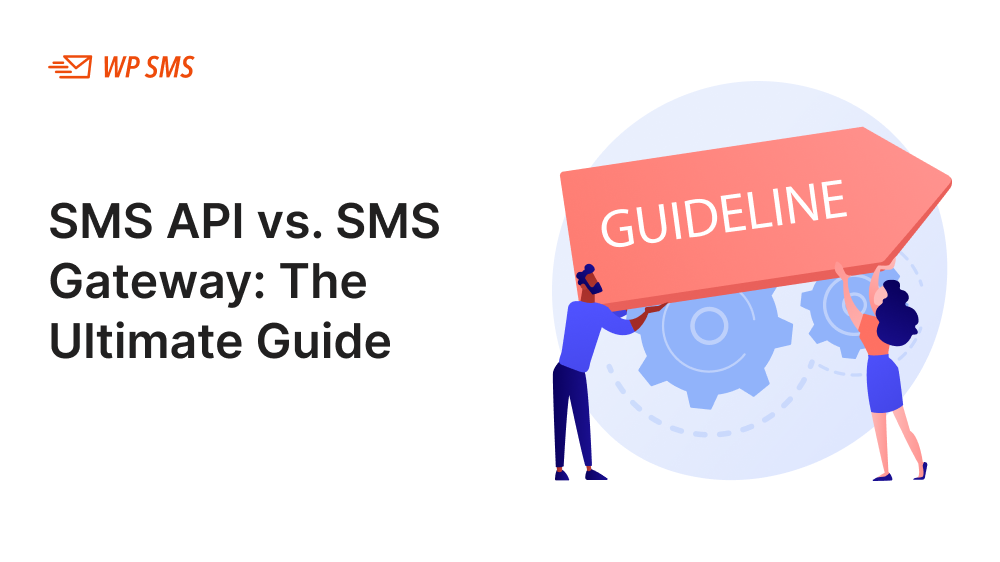SMS technology plays a vital role in how businesses communicate. Whether sending appointment reminders, marketing offers, or security codes, companies rely on SMS to connect with customers quickly and directly.
However, implementing SMS requires choosing the right tools. For this purpose, it is essential for businesses to understand different concepts and tools. SMS gateway and SMS API are concepts that are sometimes confused with each other.
In fact, An SMS Gateway is a service provider that enables businesses to send SMS messages at scale. It simplifies the delivery of SMS messages, such as bulk SMS campaigns (e.g., marketing promotions) and transactional alerts, using tools like SMS APIs.
In this article, we will explore SMS APIs and SMS Gateways. We will define what each concept is, explain their practical uses, and compare their differences.
What is an SMS Gateway?
An SMS gateway can be found as a physical device or as a cloud service. It connects applications and websites to networks and allows businesses to send and receive text messages. Actually, SMS Gateways are bridges between a website/application and telecom operators.
The job of an SMS gateway is translating messages into a format that mobile networks can understand. Then it routes those messages through carriers (like Vodafone or AT&T) to reach phones. As a result, what SMS gateways do is sending SMS messages easily, such as bulk SMS campaigns and transactional SMS alerts.
In general, there are two kinds of SMS gateways. Some of the SMS gateways, like Twilio, are cloud-based services. They provide secure SMS APIs to businesses for sending SMS. However, there is another type of SMS gateway: a physical device, such as GSM modems. They have no API and do not require an internet connection.
Although sending SMS via physical SMS gateways does not need the internet, they require technical knowledge, and you need to be familiar with AT Commands to program them. They are also generally less secure than cloud SMS gateways and tend to be slow.
What can you use SMS Gateway for?
Whether your SMS gateway is a cloud service or a physical device, you can use them for sending various SMS messages. You can use it to send bulk SMS campaigns, personalized transactional SMS messages, OTP messages, or even receive SMS texts.
Although physical SMS gateways do not rely on third-party providers, they are significantly slower than cloud-based gateways for sending any type of SMS message. Plus, physical gateways lack built-in tools for personalization or scheduling. In contrast, cloud-based SMS gateways can send millions of personalized messages in parallel.
For example, if a retail running a holiday promo needs to send 50,000 personalized offers, a GSM modem would take days, while a cloud API completes this in minutes.
Moreover, physical SMS gateways have no guaranteed delivery or retries if messages fail. However, cloud-based SMS gateways usually offer automatic retries, delivery reports, and SLA-backed uptime.
Finally, cloud-based SMS gateways provide you with a dashboard to send your messages to subscribers. If you need to send messages from your application or website, they also offer another option, an SMS API, which facilitates this process. In the next section, we will explain what SMS APIs are and how you can use them.
What is an SMS API?
An SMS API is the interface developers use to send messages programmatically. However, the API must connect to an SMS Gateway to actually deliver messages to mobile networks. Think of it like a car’s steering wheel (the API) and the engine (the Gateway). The steering wheel lets you control the car, but it needs the engine to move.
The Gateway is the underlying system that connects to telecom networks. APIs are a service layer built on top of Gateways to simplify integration for developers. For example, when you use Twilio’s SMS API, you are actually using Twilio’s pre-built Gateway infrastructure behind the scenes.
In fact, to send SMS automatically from your website or app, you need an SMS API. For example, an e-commerce site uses an API to trigger SMS order confirmations whenever a customer checks out.
SMS APIs are both flexible and easy to use for developers. Developers do not need to manage Gateway infrastructure, but the SMS gateway providers handle routing, carrier partnerships, and uptime.
Today, most providers offer SMS APIs as the default method to access their gateway infrastructure, enabling websites and applications to easily send personalized and scheduled SMS messages to their customers.
What can you use SMS API for?
SMS APIs are versatile because they integrate with software to automate workflows, personalize at scale, and reach customers instantly.
SMS APIs eliminate manual sending for transactional alerts or bulk SMS campaigns. Using them makes working with SMS gateways easy and you can send 10 or 10,000+ messages with no hardware limitations in minutes.
SMS APIs enable sending SMS messages securely. They can protect sensitive data. Plus, personalization becomes so easy with SMS APIs.
In addition, since SMS providers monitor messages in real-time by integrating with telecom carriers, SMS APIs can generate analytics by tracking every step of a message’s journey, and even URLs in messages become trackable. They can return metrics such as delivery rates, open rates, conversion rates, etc.
Here is a list of what can be done with SMS APIs:
Transactional Messaging:
- Real-time order/payment confirmation SMS messages.
- Account activity alerts (e.g., login attempts, balance updates).
Security & Authentication:
- One-time passwords (OTPs) for logins.
- Two-factor authentication (2FA).
- Fraud alerts (e.g., suspicious transactions).
Marketing & Sales:
- Personalized bulk SMS campaigns (e.g., “Hi Joe, enjoy 20% off!“).
- Flash sales, holiday promotions, or loyalty program updates.
- Abandoned cart reminders.
Customer Support:
- Two-way communication (e.g., Q&A, troubleshooting).
- Post-purchase surveys or feedback requests.
- Live chat support via SMS (e.g., chatbots).
Logistics & Operations:
- Delivery tracking notifications.
- Warehouse/inventory alerts (e.g., low stock).
- Employee shift reminders or emergency alerts.
Appointment Management:
- Booking confirmations (e.g., doctor’s appointments).
- Event reminders (e.g., webinars, concerts).
- Rescheduling/cancellation updates.
Automation:
- Trigger SMS based on user actions (e.g., form submissions).
- CRM/ERP integrations (e.g., Salesforce updates via SMS).
- IoT alerts (e.g., smart device notifications).
Industry-Specific Use Cases:
- Healthcare: Prescription refill reminders, lab results.
- Education: Class cancellations, exam schedules.
- Banking: Bill payment reminders, loan approvals.
- Travel: Flight updates, check-in notifications.
SMS API vs. SMS Gateway: A Short Comparison
While SMS APIs and SMS Gateways both enable businesses to send text messages, they serve different roles:
| Aspect | Physical SMS gateway | Cloud-based SMS gateway | SMS API |
| Infrastructure | Hardware (e.g., GSM modem, server). | Virtual infrastructure (hosted by provider). | Software interface (code-driven). |
| Setup | Requires physical hardware, SIM cards, and protocols (e.g., SMPP). | No hardware—managed by provider. | Requires coding (e.g., REST API calls). |
| Scalability | Limited by hardware (e.g., 1 SMS/5 seconds per modem). | Scales instantly (handles millions of messages). | Scales with code (depends on provider’s backend). |
| Use Cases | Small-scale projects, IoT devices, offline/local use. | Bulk campaigns, enterprise messaging. | Real-time alerts, app/CRM integrations, automation. |
| Cost | High upfront (hardware + carrier fees). | Pay-per-use (no upfront costs). | Pay-per-use (often bundled with cloud gateway services). |
| Security | Manual setup (e.g., firewalls). | Built-in encryption, compliance (GDPR, TCPA). | Provider-managed security. |
| Integration | Requires protocols like SMPP, HTTP. | Dashboard + API access. | Direct code integration (e.g., Python, Java). |
| Maintenance | Manual (hardware/software updates). | Fully managed by provider. | Minimal (provider handles infrastructure). |
| Speed | Slow (~1 SMS/5 seconds). | Fast (thousands of SMS/second). | Instant (depends on provider’s speed). |
| Global Reach | Limited to SIM card’s carrier. | Worldwide carriers. | Worldwide carriers (via provider). |
How does WP SMS help you integrate with SMS gateways and SMS APIs?
Integrating SMS functionality into a website typically requires technical expertise. However, the WP SMS plugin simplifies this process for WordPress users by acting as a bridge between your website and SMS gateways and no coding needed.
WP SMS supports dozens of SMS gateways (e.g., Twilio and Plivo), and instead of writing code to connect to their APIs, you simply:
- Select your preferred gateway from the plugin’s dashboard.
- Enter your API credentials (provided by the gateway).
- Start sending SMS directly from WordPress.
This eliminates the need to understand protocols like SMPP or REST API development. In addition, WP SMS ensures secure communication with SMS gateways.

In fact, WP SMS handles the technical heavy lifting. For example:
- Transactional SMS: Automate order confirmations or OTPs using plugins like WooCommerce, without writing a single line of code.
- Bulk SMS Campaigns: Send personalized messages to subscribers via your WordPress dashboard, bypassing manual API calls.
- Two-Way Messaging: Enable customer replies (e.g., surveys, support tickets) with pre-configured workflows.
Conclusion
SMS Gateways and APIs serve different roles in business messaging, and understanding their types is key to choosing the right solution.
Physical SMS Gateways, like GSM modems, rely on hardware and SIM cards to send messages. They work offline and suit niche use cases, such as IoT devices or locations with limited internet access. However, they lack scalability and require technical setup.
In contrast, cloud-based SMS Gateways operate virtually, managed by providers like Twilio. These gateways handle high-volume messaging, global carrier networks, and real-time delivery—all without physical hardware. Most cloud gateways include SMS APIs as part of their service, letting developers automate messaging without building infrastructure from scratch.
SMS APIs are the backbone of cloud-based gateways, offering flexibility and power. They enable businesses to send transactional SMS (like OTPs or order alerts), run personalized bulk campaigns, and integrate messaging into apps or websites.
APIs simplify tasks such as two-factor authentication, shipping notifications, and appointment reminders, while ensuring security and scalability.
Unlike physical gateways, APIs adapt instantly to demand, making them ideal for businesses needing real-time communication. For example, a retail app can use an SMS API to automatically notify customers about deliveries, while a clinic can automate appointment confirmations, all with minimal coding.
For WordPress users, the WP SMS plugin bridges the gap between technical complexity and ease of use. It supports popular cloud-based gateways (like Twilio or Plivo) and their APIs, allowing non-developers to send SMS directly from WordPress.
Whether setting up WooCommerce order alerts, membership reminders, or newsletter campaigns, the plugin requires no coding. By leveraging the plugin, businesses can focus on engagement, not infrastructure, while enjoying the benefits of cloud gateways and APIs.
FAQs
What is an SMS Gateway?
An SMS Gateway is a system that connects your software or hardware to mobile networks to send/receive text messages. It acts as a bridge between your systems and telecom carriers.
What is an SMS API?
An SMS API (Application Programming Interface) is a tool developers use to send messages programmatically. It connects your apps or websites to an SMS Gateway, enabling automated messaging like OTPs, alerts, or bulk campaigns.
What is the difference between an SMS API and an SMS Gateway?
· SMS Gateway: The infrastructure (physical or cloud-based) that routes messages.
· SMS API: The interface that lets you access and control the Gateway through code.
Most cloud-based Gateways include APIs, while physical Gateways (like GSM modems) require manual setup.
What are the types of SMS Gateways?
· Physical SMS Gateways: Hardware-based (e.g., GSM modems). Best for offline use, IoT, or small-scale projects.
· Cloud-based SMS Gateways: Virtual services (e.g., Twilio). Handle bulk messaging, global reach, and include APIs.
Are SMS Gateways secure?
Cloud-based Gateways with APIs offer encryption and compliance (e.g., GDPR). Physical Gateways require manual security setups (e.g., firewalls).
Which is cheaper: SMS API or Gateway?
Cloud-based APIs/Gateways are cost-effective for most users. Physical Gateways have high upfront costs (hardware, SIM cards).
